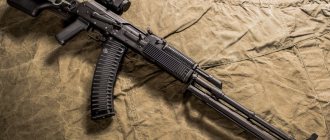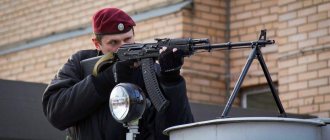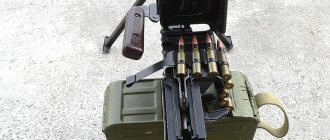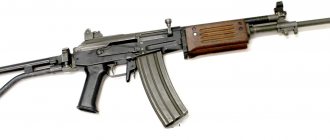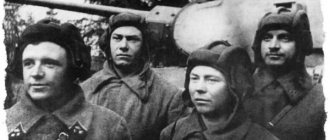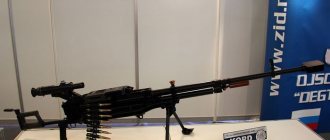In 2016, at the Army-2016 military weapons exhibition, visitors saw a completely new model from the Kalashnikov Concern. It was an RPK-16 machine gun, with a short barrel. Light automatic weapons were positioned as a completely new development of the Kalashnikov Concern.
Despite the shortened barrel, in the description of the characteristics of the RPK-16 one could see that it was not inferior to its world analogues, so the new machine gun attracted the attention of not only ordinary visitors, but also representatives of the military command of several countries.
Dynamic development of the Kalashnikov Concern
Unlike most domestic defense industry enterprises, the Kalashnikov Concern has been developing very dynamically in recent years. This concern tries to release some new weapon every year, both among hunting and among combat models. Some ill-wishers accuse the Kalashnikov Concern of speculating on the name of the famous Kalashnikov assault rifle. This is expressed in the fact that the names “AK” and the like are given to models that operate according to a completely different scheme.
The new Kalashnikov RPK-16 machine gun is one of the new models that is currently approved by the Ministry of Defense of the Russian Federation.
At the Army-2016 exhibition, the general director of the Kalashnikov Concern loudly announced that the contract for the supply of an experimental batch of RPK-16 had already been signed, and in 2022 the serial assembly of new light machine guns for the Russian army would begin.
Notes
- (unavailable link). Retrieved August 19, 2014.
- (unavailable link). Retrieved August 19, 2014.
- (unavailable link). Retrieved September 23, 2014.
- (unavailable link). Retrieved August 2, 2009.
- Fedoseev S. L.
Russian machine guns. Heavy fire.. - M.: Yauza, 2009. - 608 p. — ISBN 978-5-699-31622-9. - Kalashnikov M. T.
Notes of a gunsmith designer. - M.: Voenizdat, 1992. - 304 p. — 50,000 copies. — ISBN 5-203-01290-3. - Resolution of September 8, 1998 N 1077 “On the adoption of certain types of weapons and cartridges by the Armed Forces of the Russian Federation”
- (unavailable link). Retrieved October 16, 2015.
- ↑. Bangladesh Military Forces. Retrieved May 4, 2010. (inaccessible link)
- ↑ (undefined). SINA Corporation. Retrieved May 4, 2010.
- ↑ (inaccessible link). Retrieved August 15, 2014.
- ↑
- (unavailable link). Retrieved January 14, 2011.
- (unavailable link). Retrieved January 14, 2011.
- (unavailable link). Retrieved January 25, 2015.
- (unavailable link). Retrieved August 19, 2014.
- (unavailable link). Retrieved September 23, 2014.
- (unavailable link). Retrieved August 19, 2014.
- (unavailable link). Retrieved September 23, 2014.
- (unavailable link). Retrieved January 25, 2015.
- (unavailable link). Retrieved April 11, 2022.
- (unavailable link). Retrieved August 15, 2014.
- (unavailable link). Retrieved August 15, 2014.
- ↑ Jones, Richard D. Jane's Infantry Weapons 2009/2010
. Jane's Information Group; 35 edition (January 27, 2009). ISBN 978-0-7106-2869-5. - ↑ (inaccessible link). Retrieved December 16, 2011.
- . Retrieved January 6, 2013.
- . Retrieved May 4, 2010.
Fundamental differences between the new product and other models of the concern
According to many experts in the field of small arms, the new machine gun is a real novelty, although there is also an opposite opinion. The following design features of the RPK-16 speak in favor of the fact that this is a new model:
- Possibility of configuration with both long and short barrels;
- Compact dimensions of the machine gun;
- Light weight for a machine gun;
- Drum shop.
Opponents say that these features make the RPK-16 just another modification of the concern’s earlier models, since the design uses developments that were used in the AK-12 and AK-400. After analyzing the design features of the AK-400 machine gun, they conclude that the RPK-16 is just a cheaper version of this model.
The RPK-16 was created for the most popular combat cartridge, 5.45x39 caliber, which has been used for many years to power the AK-74 assault rifle and the RPK-74 machine gun. Many gunsmiths are confident that the RPK-16 should completely replace the outdated machine guns that have been in service with the Russian Army for more than 40 years.
To further interest the potential customer, whose contract promises fabulous money, the Kalashnikov Concern emphasizes that the new machine gun has a universal design, which makes it an ideal weapon for special forces.
Just like the RPK-400 model, which was developed earlier, the RPK-16 was created taking into account the requirements of the Ministry of Internal Affairs. Initially, the new machine gun was aimed at various special units, the FSB and the security service of the President of the Russian Federation. If you believe the words of Concern General Director Kalashnikov, the contract with the Ministry of Internal Affairs and the army is a done deal, and everything depends only on the timing necessary to establish mass production.
Production
Zastava M84 machine guns
- Azerbaijan Azerbaijan: two versions of the PKM are produced (chambered 7.62x54 mm R): the general-purpose UP-7.62
(weight 7.5 kg) and the special
HP-7.62
(weight 7 kg). - Bangladesh Bangladesh: Produced by Bangladesh Ordnance Factories under the designation BD-14
. - Bulgaria Bulgaria: in 1971-1973, serial production of the PK machine gun was mastered and started, and in 1976-1978 - of the PKT tank machine gun, now PKM is being produced;; subsequently, modified versions of the PKM machine gun chambered for 7.62x51 mm NATO cartridge were developed;
- Iran Iran: Produced by Defense Industries Organization;
- PRC PRC: PKT is produced under the name Type 59T
;.
PKM is produced under the name Type 80
.
The export version chambered for 7.62 NATO is produced under the designation CF06
or
CS/LM4
; - DPRK DPRK: produced under the name Type 73
in a version with combined power supply: a 30-round magazine or cartridge strip. - Poland Poland: PKM, PKT machine guns and their modifications have been produced since 1968; after the transition to NATO standards in 1997-2000, the Tarnow Mechanical Plant developed the UKM-2000
chambered for 7.62x51 mm. - Russia Russia: PKM
,
PKTM
,
PKMS
,
PKMB
are produced; - Romania Romania: the PKM machine gun is produced by Romarm (a division of the Kudzhir Arms Factory) under the name Mitraliera md.
66 and PKT under the name
MMB
; - Serbia Serbia: the PK machine gun is produced under the name Zastava M84
, PKT - under the name
Zastava M86
; - Sudan Sudan: Manufactured by Military Industry Corporation under the name Mokhtar
; - Ukraine Ukraine: PKM (under the name KM-7.62
) and PKT (under the name
KT-7.62
)
For what purposes is the RPK-16 machine gun intended?
The light machine gun is a universal weapon, which is repeatedly emphasized by its manufacturer. Its main combat missions are as follows:
- Destruction of enemy personnel in urban or rural areas;
- Shooting to kill indoors;
- Powerful fire support for assault troops;
- Covering landing groups returning from a mission under enemy fire.
In addition to these tasks, the RPK-16 can be used in almost any special operations, the conduct of which must be ensured by dense fire support from small arms.
The RPK-74 machine gun, which is currently the main combat machine gun of the Russian army, is considered a highly effective weapon, but in terms of its tactical and technical characteristics it has long been hopelessly behind modern world analogues.
The AK-74's main competitors are the American M-249 machine gun and the Belgian FN Minimi. These models are compact, mobile, and have great firepower. As a feeding method, foreign samples can use both removable box-type magazines and metal belts. On top of that, foreign machine guns have removable barrels and are equipped with handles for ease of transportation.
Unlike their foreign colleagues, the designers of the Kalashnikov Concern decided to equip their machine gun with only a drum magazine. Some experts see in the new Russian machine gun similarities with the Austrian Steyr AUG LMG and the Chinese QBB-95, although the RPK-16 is superior in firepower to both the Chinese and Austrian machine guns.
Tape or store?
Returning to the global arms market, special attention should be paid to the fact that simultaneously with the advent of the PKK in the 70s, interest in weapons with replaceable power supply began to grow. And here you cannot pass by the Belgian FN Minimi machine gun, which proved itself to be excellent at that time.
The Minimi system is powered by a NATO small-caliber cartridge. It is worth noting that the developers abandoned the idea of bringing the machine gun model into uniformity with the range of assault rifles produced by the same company. That is, FN Minimi was created from scratch and has a unique design.
What this entails, what risks the designers took in finding the necessary parts (if replacements were necessary), can be assumed without going into a detailed study of the design documentation. The risk paid off.
The main feature of Minimi is its replaceable power supply. The choice between belt-fed and magazine-fed is a subject of long-standing debate among weapons designers around the world. More than a dozen children and more than a dozen people worked on this issue. And each time, one of the sides gained the upper hand in the discussion, while the other remained unconvinced and on its own path of development. As a result, various weapon models with different types of ammunition were created. That is, machine guns and assault rifles (with a separate magazine type), belt machine guns.
On the one hand, the belt links weigh extremely little, and when loaded with cartridges, they fit conveniently into machine gun boxes of any shape, which makes it possible to carry a significant amount of ammunition. On the other hand, the parts of the tape are easily susceptible to corrosion, which, if it gets into the cartridge dispensing system in a machine gun, can lead to a misfire or completely disable the weapon. Not to mention the fact that with such a system for feeding cartridges, dirt, dust and sand can also get into the chamber, which will definitely lead to the weapon stopping, if not immediately, but after a certain time.
Stores make this task much easier. This means using a magazine from an assault rifle, which is very convenient, but this method of feeding has a bad effect on the amount of ammunition and transportation, which is not in reasonable compliance with the carried weight.
Loose machine gun belt, designed for 200 rounds, is placed in a plastic box. The flax supply compartment is located on the left side of the product. In this case, the box with cartridges is attached from below. This functionality was implemented on the Soviet RPD long before the appearance of the FN Minimi.
If the tape runs out and there is no other one at hand, it is possible to use a magazine from an assault rifle with the same cartridges. This is exactly the principle that the new RPK-16 incorporates.
Design features of the RPK-16
Although the previous model of the Russian light machine gun RPK-400 had a dual type of power supply, in the new model the designers took the path of reducing the cost, leaving only the possibility of connecting the following magazines:
- Standard drum for 96 rounds;
- A standard horn from a Kalashnikov assault rifle with 30 rounds;
- Machine gun horn from RPK-74 with 45 rounds.
I’m glad that it remains possible to use standard horns from AK and RPK, which will come in very handy in a combat situation.
The main design features of the RPK-16 include the following:
- A sector sight is installed on the receiver cover;
- The muzzle brake was taken from the AK-400 without any changes;
- The front sight is located on the gas block;
- There is a folding stock.
The use of a sector sight ensures ease of aiming even at dusk. The RPK-16 is also equipped with a silencer, which makes it suitable for use in special operations that must take place in the utmost secrecy. In addition to the silencer, a device for low-noise shooting can be installed. This device not only dampens the sound of shots, but also works as a flame arrester. A machine gunner can remain unnoticed by the enemy for a long time, providing fire support without the risk of being detected.
The ability to change the barrel from long to short helps the machine gunner prepare the weapon for various types of operations. If a long barrel is perfect for firing in open space, then for assault operations in cramped urban spaces or for storming buildings it is better to use a short one.
Disassembling the machine gun
To carry out technical inspection, cleaning and lubrication of the weapon, it is disassembled in two ways. It is similar to the stages of PCM.
To carry out partial disassembly, perform the following steps:
- The weapons are removed from the stands and unloaded.
- The “Pecheneg” is installed on the bipod, then on a prepared surface or table, the weapon is positioned with the muzzle zone forward.
- Remove the cartridge box using the latch adjustment. It is visually recorded that there is no ammunition in the chamber by opening the barrel cover. The fuse is set to the “Fire” position. The bolt is moved to the rear position - there should be no cartridges in the chamber.
- They take out the pencil case, and from it take all the necessary accessories for disassembly and cleaning.
- The guide rod is separated from the return spring by retracting and lifting the tip of the rod, followed by its obligatory removal and removal of the spring.
- Take out the frame with the shutter. The frame is first pulled back to the maximum, then they are separated by moving the bolt back, forward and to the right.
- The firing pin is released from the bolt and moved back behind the protrusion.
- Separate the barrel by moving the lock to the left side; in case of a difficult, difficult move, you can help yourself by “arming yourself” with the bolt frame.
Partial disassembly completed.
The second method is complete disassembly, it is performed after incomplete disassembly, and it is carried out according to the following steps:
- the shutter is disassembled - the pin is knocked out along with the ejector axis;
- in a perpendicular position, helping with the sleeve, set the gas regulator to the neutral position, and then, using a hammer, lightly hit it, knocking the regulator off the gas chamber;
- with the same position of the weapon, remove the flash suppressor - pressing its latch into the base of the front sight with your finger, then unscrew it;
- the trigger mechanism is disassembled, adjusting the safety all the way up, pressing the trigger, and taking out the safety, then the axle, lever with spring and hook;
- the gas piston tube and bipod are separated from the receiver, moving forward.
Complete disassembly is complete. After cleaning and subsequent lubrication, assembly is carried out in strict sequence, in reverse order. After assembly, it is necessary to check the serviceability and operation of the weapon.
Advantages and disadvantages of the RPK-16 light machine gun
The new Kalashnikov Concern machine gun has not yet been studied well enough to say anything specific about its advantages or disadvantages. However, even if you look at the appearance of the weapon and read the technical characteristics, you can draw certain conclusions. The main advantages are as follows:
- From the appearance of the weapon, it becomes clear that its purpose is combat in urban environments. For special forces, this powerful and rapid-fire weapon will come in handy;
- Ammunition of 45x39 mm caliber is the most common in the Russian army, so the choice of RPK-16 caliber is very successful;
- The 96-round drum magazine allows for long-lasting fire;
- The low weight of the product contributes to the ease of use of the weapon;
- Low recoil contributes to accuracy, so this machine gun is very accurate.
As negative aspects of the RPK-16, one can cite the statements of skeptics who claim that the new machine gun is only a simplified model of the RPK-400. In addition, the Pecheneg machine gun, which is produced at the Degtyarev plant, is a more powerful weapon. To this it can be argued that the RPK-16 is intended for other combat missions. The main task of the Pecheneg is to control the territory, and the RPK-16 is more suitable for surprise attacks in urban areas.
Machine gun rifle
In modern combat conditions, it is always necessary to have at hand a weapon that can adapt as much as possible to the conditions in which the battle takes place. This is precisely the goal that the Kalashnikov concern pursued when creating the new RPK-16 machine gun.
Creating a weapon that combines a machine gun and an assault rifle is not the first attempt. Suffice it to recall the Israeli Galil assault rifle, a development by Israel Galili based on the Kalashnikov assault rifle. An attempt to combine these types of weapons was unsuccessful.
Another thing is the Singaporean Ultimax 100 model, created by James Sullivan's team of engineers. A similar model is still in demand today. It is for this reason that the concern was tasked with creating weapons that would not only be in demand as weapons for military units or special forces, but would also be exported.
Operating countries
PKM of the Finnish army.
A Ugandan soldier with PKM is participating in the African Union Military Mission in Somalia (AMISOM). Stands just after sunrise on January 20, 2012 with Somali National Army (SNA) soldiers during an advance into rebel territory from Harakat al-Shabab. The operation is being carried out by the SNA with the support of the African Union to occupy the areas around the university in the far northern point of Mogadishu.
- Albania
- Afghanistan
- Azerbaijan
- Armenia
- Bangladesh: in the combined arms formations of the Bangladesh Army and the Presidential Guard
- Belarus
- Bulgaria
- Bosnia and Herzegovina
- Hungary
- Vietnam
- Guinea
- Guinea-Bissau
- GDR
- Georgia
- Zambia
- Israel
- Iraq
- Iran
- Cape Verde
- Cambodia
- Kazakhstan
- China
- Kyrgyzstan
- DR Congo
- Republic of the Congo
- Croatia
- Cuba
- Poland
- Russia
- Romania
- Sao Tome and Principe
- USSR
- Serbia
- Syria
- Slovakia
- Slovenia
- Laos
- Latvia
- North Macedonia
- Mali
- Mozambique
- Moldova
- Mongolia
- Tajikistan
- Türkiye
- Turkmenistan
- Uganda
- Ukraine
- Uzbekistan
- Finland (was known as 7.62 KK PKM
). - Croatia
- Chad
- Czech
- Switzerland
- Sweden (known as Kulspruta 95)
- Sri Lanka: in the Sri Lanka Army. About 200 Type 80 machine guns were supplied by Norinco.
- Eritrea
- Estonia
- Yugoslavia
Combat use of the PKM machine gun
The Kalashnikov machine gun, as well as its modifications, as well as the AKM assault rifle, have been actively used over the past 30 years in almost all military conflicts. The modernized Kalashnikov machine gun has proven itself to be an effective, reliable and powerful weapon; it is often used by troops of a number of Western countries. A certain number of PKMs are in service with the Israeli army.
The PKM is serviced by a crew of two people. The machine gun is supplied with a device for stuffing belts, a spare barrel, 600 rounds of ammunition (2 belts of 100 and 2 of 200 rounds). The total weight of the entire PCM set is approximately 30 kilograms. The crew can also receive a night sight and a Samozhenkov machine (weighing 9 kg). During the Arab-Israeli wars, Egyptian infantrymen often installed tank sights on PCs, which made it possible to conduct targeted fire at a distance of over 1800 meters.
